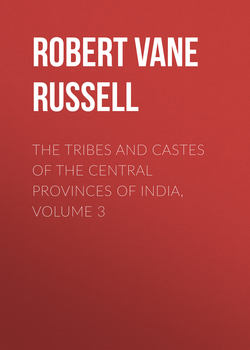Читать книгу The Tribes and Castes of the Central Provinces of India, Volume 3 - Robert Vane Russell - Страница 46
Gond
(d) Birth and Pregnancy
28. Superstitions about pregnancy and childbirth
ОглавлениеNo special rites are observed during pregnancy, and the superstitions about women in this condition resemble those of the Hindus.65 A pregnant woman must not go near a horse or elephant, as they think that either of these animals would be excited by her condition and would assault her. In cases where labour is prolonged they give the woman water to drink from a swiftly flowing stream, or they take pieces of wood from a tree struck by lightning or by a thunder-bolt, and make a necklace of them and hang it round her neck. In these instances the swiftness of the running water, or of the lightning or thunder-bolt, is held to be communicated to the woman, and thus she will obtain a quick delivery. Or else they ask the Gunia or sorcerer to discover what ancestor will be reborn in the child, and when he has done this he calls on the ancestor to come and be born quickly. If a woman is childless they say that she should worship Bura Deo and fast continually, and then on the termination of her monthly impurity, after she has bathed, if she walks across the shadow of a man she will have a child. It is thus supposed that the woman can be made fertile by the man’s shadow, which will be the father of the child. Or she should go on a Sunday night naked to a sāj tree66 and pray to it, and she may have a child. The sāj is the tree in which Bura Deo resides, and was probably in the beginning itself the god. Hence it is supposed that the woman is impregnated by the spirit of the tree, as Hindu women think that they can be made fertile by the spirits of unmarried Brāhman boys living in pīpal trees. Or she may have recourse to the village priest, the Bhumka or the Baiga, who probably finds that her barren condition is the work of an evil spirit and propitiates him. If a woman dies in the condition of pregnancy they cut her belly open before burial, so that the spirit of the child may escape. If she dies during or soon after delivery they bury her in some remote jungle spot, from which her spirit will find it difficult to return to the village. The spirit of such a woman is supposed to become a Churel and to entice men, and especially drunken men, to injury by causing them to fall into rivers or get shut up in hollow trees. The only way they can escape her is to offer her the ornaments which a married woman wears. Her enmity to men is due to the fact that she was cut off when she had just had the supreme happiness of bearing a child, and the present of these ornaments appeases her. The spirit of a woman whose engagement for marriage has been broken off, or who has deserted her husband’s house for another man’s, is also supposed to become a Churel. If an abortion occurs, or a child is born dead or dies very shortly after birth, they put the body in an earthen pot, and bury it under the heap of refuse behind the house. They say that this is done to protect the body from the witches, who if they get hold of it will raise the child’s spirit, and make it a Bir or familiar spirit. Witches have special power over the spirits of such children, and can make them enter the body of an owl, a cat, a dog, or a headless man, and in this form cause any injury which the witch may desire to inflict on a human being. The real reason for burying the bodies of such children close to the house is probably, however, the belief that they will thus be born again in the same family. If the woman is fat and well during pregnancy they think a girl will be born, but if she is ailing and thin, that the child will be a boy. If the nipples of her breasts are of a reddish colour they think the birth of a boy is portended, but if of blackish colour, a girl. When a birth occurs another woman carefully observes the knots or protuberances on the navel-cord. It is supposed that the number of them indicates the further number of children which will be born to the mother. A blackish knot inclining downwards portends a boy, and a reddish one inclining upwards a girl. It is supposed that an intelligent midwife can change the order of these knots, and if a woman has only borne girl-children can arrange that the next one shall be a boy.
65
See articles on Kunbi, Kurmi, and Mehtar.
66
Boswellia serrata.
